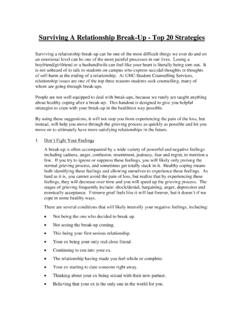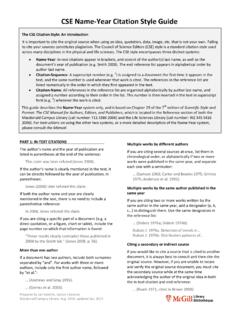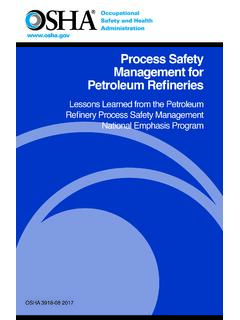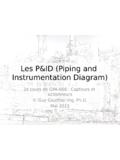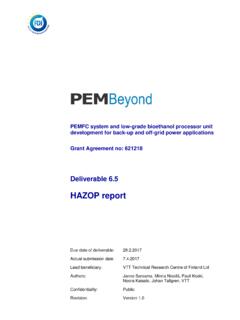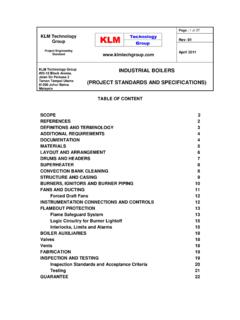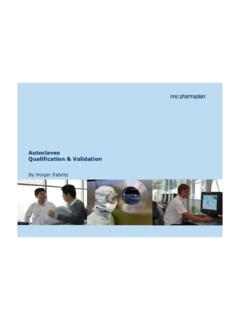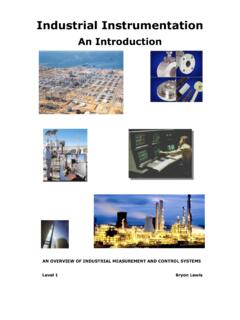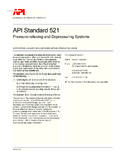Transcription of PROCESSING OF FOODS PROCESSING - McGill University
1 PROCESSING OF FOODS PROCESSING . RAW PRODUCT. PROCESS. PROCESSED. Michael Ngadi, PhD., PRODUCT. Bioresource Engineering Department McGill University food PROCESSING PROCESSING OF food . OPERATIONS. PRIMARY PROCESSING : SECONDARY PROCESSING : - conversion of raw materials - conversion of ingredients into to food commodities edible products food PROCESSING is the conversion of Eg: milling, chilling, drying, - this involves combining FOODS agricultural product to consumable etc. in a particular way to change properties. substances which have particular Eg: processed meats, dairy products, beverages and textural, sensory and nutritional alcoholic drinks, food packaging, properties using commercially feasible baking, freezing, dehydrating canning and bottling. methods 1. WHY PROCESS? food PRODUCTS. Products may be made by several processes. Interactions to convert to edible products between product and processes differ. to preserve Starch products Meat products a.
2 Bread a. Products from cattle to extend availability and provide accessibility b. Cakes and biscuits b. Products from pigs c. Pasta to provide variety and choice d. Rice products Fish products e. Corn products Milk products to provide convenience Oil products a. Margarine Chocolate manufacture b. low fat spreads). to add value Drinks TYPICAL food PROCESSES UNIT OPERATIONS. Several steps are required to manufacture food products. Material Handling The specific details of each may differ, but the basic principles are the same. Unique steps or Cleaning Separating Source ingredients Fillings added operations taken Size reduction Delivery of ingredients Finish applied to prepare food Fluid Flow Mixing Storage of ingredients (hoppers, bins, etc.). Cooked products Heat transfer Cooled Weigh and mix Concentration ingredients - formulation Stored These operations Drying Mixture shaped or Forming formed extrusion, cutting, rolling, etc.
3 Packaged and labeled can stand alone Packaging Distribution Controlling 2. TERMS PROCESS FLOWSHEETS. Process Design: the design of food processes Process flowsheets are graphical and manufacturing methods, including process representations of the layout and flow of flowsheets, design of PROCESSING and control equipment and materials in the plant. equipment, and economic evaluation of the process. PBD: Process block diagram Plant Design: the design of whole PROCESSING PFD: Process flowsheet diagram plant, including the PROCESSING /control equipment, the utilities, the plant buildings, and the waste PCD: Process control diagram treatment units. PID: piping and instrumentation diagram 3. Energy accounting (process block) diagram of tomato paste manufacturing based on an 8 hour shift 4. GOOD MANUFACTURING. PRACTICES (GMPs). GMPs are a combination of manufacturing and management practices aimed at ensuring that food products are consistently produced to meet specifications and customer expectations.
4 GMPs requirements related to the design and layout of food plants include: Single-floor versus multistory buildings Land space for future expansion Waste disposal Building details (drainage, doors, lighting, ventilation, plumbing). food SAFETY PROGRAMS. AND HACCP. Conduct a hazard analysis (biological, chemical, and physical). Determine the Critical Control Points (CCPs). Establish a critical limits for each CCP. Establish a system to monitor each CCP. Establish the corrective action to be taken when monitoring indicates that a particular CCP is not under control Establish procedures for verification to confirm that the HACCP. system is working effectively Establish documentation concerning all procedures and record appropriate to these principles and their application 5.
